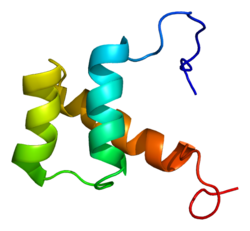Homöoboxprotein DLX-5
Protein in Homo sapiens
Das Homöobox-Protein DLX-5 ist ein Protein, für welches das bei Menschen vorhandene DLX5-Gen codiert.[1][2]
| DLX5 | ||
|---|---|---|

| ||
| Struktur des DLX5-Proteins |
Funktion
BearbeitenDas Gen ist den Drosophila-„Distal-less“-Genen (DLX) sehr ähnlich. Die „Distal-less“ (Dlx)-Genfamilie umfasst mindestens sechs verschiedene Elemente, DLX1–DLX6. Das codierte Protein hat eine Funktion bei der Knochenentwicklung und bei Frakturheilungen. Mutationen in dem Gen, das in einer Konfiguration mit anderen Vertretern der Genfamilie auf dem langen Arm von Chromosom 7 vorkommt, können mit einer Fehlbildung („split-hand/split-foot“) verbunden sein.[2]
Interaktion
BearbeitenDLX5 wies Protein-Protein-Interaktionen bei DLX2,[3] MSX1[3] und Msh homeobox 2 auf.[3]
Mutation
BearbeitenMutationen im DLX5Gen sind an der Ektrodaktylie beteiligt.[4]
Einzelnachweise
Bearbeiten- ↑ Simeone A, Acampora D, Pannese M, D’Esposito M, Stornaiuolo A, Gulisano M, Mallamaci A, Kastury K, Druck T, Huebner K, et al.: Cloning and characterization of two members of the vertebrate Dlx gene family. In: Proc Natl Acad Sci U S A. 91. Jahrgang, Nr. 6, April 1994, S. 2250–4, doi:10.1073/pnas.91.6.2250, PMID 7907794, PMC 43348 (freier Volltext).
- ↑ a b Entrez Gene: DLX5 distal-less homeobox 5. Abgerufen am 28. Oktober 2011.
- ↑ a b c H Zhang, Hu G, Wang H, Sciavolino P, Iler N, Shen M M, Abate-Shen C: Heterodimerization of Msx and Dlx homeoproteins results in functional antagonism. In: Mol. Cell. Biol. 17. Jahrgang, Nr. 5, Mai 1997, ISSN 0270-7306, S. 2920–32, PMID 9111364, PMC 232144 (freier Volltext).
- ↑ Shamseldin HE, Faden MA, Alashram W, Alkuraya FS: Identification of a novel DLX5 mutation in a family with autosomal recessive split hand and foot malformation. In: J Med Genet. November 2011, doi:10.1136/jmedgenet-2011-100556, PMID 22121204.
Literatur
Bearbeiten- Bapat S, Galande S: Association by guilt: identification of DLX5 as a target for MeCP2 provides a molecular link between genomic imprinting and Rett syndrome. In: Bioessays. 27. Jahrgang, Nr. 7, 2005, S. 676–80, doi:10.1002/bies.20266, PMID 15954098.
- Scherer SW, Poorkaj P, Massa H, et al.: Physical mapping of the split hand/split foot locus on chromosome 7 and implication in syndromic ectrodactyly. In: Hum. Mol. Genet. 3. Jahrgang, Nr. 8, 1995, S. 1345–54, doi:10.1093/hmg/3.8.1345, PMID 7987313.
- Hillier LD, Lennon G, Becker M, et al.: Generation and analysis of 280,000 human expressed sequence tags. In: Genome Res. 6. Jahrgang, Nr. 9, 1997, S. 807–28, doi:10.1101/gr.6.9.807, PMID 8889549.
- Zhang H, Hu G, Wang H, et al.: Heterodimerization of Msx and Dlx homeoproteins results in functional antagonism. In: Mol. Cell. Biol. 17. Jahrgang, Nr. 5, 1997, S. 2920–32, PMID 9111364, PMC 232144 (freier Volltext).
- Newberry EP, Latifi T, Towler DA: The RRM domain of MINT, a novel Msx2 binding protein, recognizes and regulates the rat osteocalcin promoter. In: Biochemistry. 38. Jahrgang, Nr. 33, 1999, S. 10678–90, doi:10.1021/bi990967j, PMID 10451362.
- Eisenstat DD, Liu JK, Mione M, et al.: DLX-1, DLX-2, and DLX-5 expression define distinct stages of basal forebrain differentiation. In: J. Comp. Neurol. 414. Jahrgang, Nr. 2, 1999, S. 217–37, doi:10.1002/(SICI)1096-9861(19991115)414:2<217::AID-CNE6>3.0.CO;2-I, PMID 10516593.
- Masuda Y, Sasaki A, Shibuya H, et al.: Dlxin-1, a novel protein that binds Dlx5 and regulates its transcriptional function. In: J. Biol. Chem. 276. Jahrgang, Nr. 7, 2001, S. 5331–8, doi:10.1074/jbc.M008590200, PMID 11084035.
- Yu G, Zerucha T, Ekker M, Rubenstein JL: Evidence that GRIP, a PDZ-domain protein which is expressed in the embryonic forebrain, co-activates transcription with DLX homeodomain proteins. In: Brain Res. Dev. Brain Res. 130. Jahrgang, Nr. 2, 2002, S. 217–30, doi:10.1016/S0165-3806(01)00239-5, PMID 11675124.
- Sasaki A, Masuda Y, Iwai K, et al.: A RING finger protein Praja1 regulates Dlx5-dependent transcription through its ubiquitin ligase activity for the Dlx/Msx-interacting MAGE/Necdin family protein, Dlxin-1. In: J. Biol. Chem. 277. Jahrgang, Nr. 25, 2002, S. 22541–6, doi:10.1074/jbc.M109728200, PMID 11959851.
- Willis DM, Loewy AP, Charlton-Kachigian N, et al.: Regulation of osteocalcin gene expression by a novel Ku antigen transcription factor complex. In: J. Biol. Chem. 277. Jahrgang, Nr. 40, 2002, S. 37280–91, doi:10.1074/jbc.M206482200, PMID 12145306.
- Strausberg RL, Feingold EA, Grouse LH, et al.: Generation and initial analysis of more than 15,000 full-length human and mouse cDNA sequences. In: Proc. Natl. Acad. Sci. U.S.A. 99. Jahrgang, Nr. 26, 2003, S. 16899–903, doi:10.1073/pnas.242603899, PMID 12477932, PMC 139241 (freier Volltext).
- Scherer SW, Cheung J, MacDonald JR, et al.: Human chromosome 7: DNA sequence and biology. In: Science. 300. Jahrgang, Nr. 5620, 2003, S. 767–72, doi:10.1126/science.1083423, PMID 12690205, PMC 2882961 (freier Volltext).
- Okita C, Meguro M, Hoshiya H, et al.: A new imprinted cluster on the human chromosome 7q21-q31, identified by human-mouse monochromosomal hybrids. In: Genomics. 81. Jahrgang, Nr. 6, 2004, S. 556–9, doi:10.1016/S0888-7543(03)00052-1, PMID 12782124.
- Hillier LW, Fulton RS, Fulton LA, et al.: The DNA sequence of human chromosome 7. In: Nature. 424. Jahrgang, Nr. 6945, 2003, S. 157–64, doi:10.1038/nature01782, PMID 12853948.
- Ota T, Suzuki Y, Nishikawa T, et al.: Complete sequencing and characterization of 21,243 full-length human cDNAs. In: Nat. Genet. 36. Jahrgang, Nr. 1, 2004, S. 40–5, doi:10.1038/ng1285, PMID 14702039.
- Gerhard DS, Wagner L, Feingold EA, et al.: The status, quality, and expansion of the NIH full-length cDNA project: the Mammalian Gene Collection (MGC). In: Genome Res. 14. Jahrgang, 10B, 2004, S. 2121–7, doi:10.1101/gr.2596504, PMID 15489334, PMC 528928 (freier Volltext).
- Rual JF, Venkatesan K, Hao T, et al.: Towards a proteome-scale map of the human protein-protein interaction network. In: Nature. 437. Jahrgang, Nr. 7062, 2005, S. 1173–8, doi:10.1038/nature04209, PMID 16189514.
- Kimura K, Wakamatsu A, Suzuki Y, et al.: Diversification of transcriptional modulation: large-scale identification and characterization of putative alternative promoters of human genes. In: Genome Res. 16. Jahrgang, Nr. 1, 2006, S. 55–65, doi:10.1101/gr.4039406, PMID 16344560, PMC 1356129 (freier Volltext).